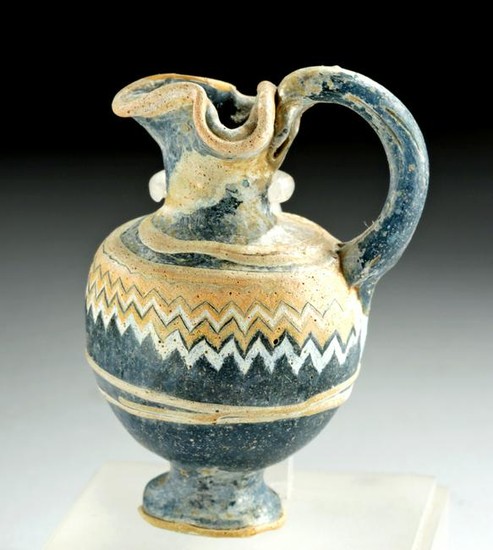Greek Core-Form Glass Oinochoe
Ancient Greece, eastern Mediterranean, probably from Rhodes, ca. early 5th century BCE. A striking core-formed glass oinochoe with a piriform body, a rounded shoulder, a narrow neck which flares into a trefoil spout, and an applied trail handle arching between the shoulder and rim, all supported atop an applied flared foot. The saturated cobalt-blue body is accentuated with canes of opaque yellow and white glass which has been feathered into a zigzag pattern across the midsection. Additional yellow and white course around the circumference of the trefoil spout, lower body, and foot. Fiery layers of silvery and rainbow-hued patina have formed across the vessel and imbue it with a stylish presentation evocative of ancient Greece! Size: 1.875" W x 2.75" H (4.8 cm x 7 cm); 3.5" H (8.9 cm) on included custom stand.
According to the Corning Museum of Glass, core forming is "the technique of forming a vessel by winding or gathering molten glass around a core supported by a rod. After forming, the object is removed from the rod and annealed. After annealing, the core is removed by scraping." (https://www.cmog.org/glass-dictionary/core-forming). This process of glass making was begun in the late 16th century BCE by glassmakers of Mesopotamia, and then adopted by Egyptian glassmakers in the 15th century BCE. The technique almost came to an end in the so-called Dark Ages of Mediterranean civilization (1200 to 900 BCE); however, by the 9th century BCE a new generation of glassmakers took up the technique once again, and between the 6th and 4th century BCE core-forming spread throughout the Mediterranean.
For some stylistically-similar examples from Camiros, Rhodes in the British Museum, published in D. B. Harden, "Catalogue of Greek and Roman Glass in the British Museum," Volume I, "Core and Rod-Formed Vessels and Pendants and Mycenean Cast Objects" (London 1981), p. 98, nos. 258-61.
Provenance: private East Coast, USA collection; ex-Martin J. Wunsch collection, New York, USA, 1980s
All items legal to buy/sell under U.S. Statute covering cultural patrimony Code 2600, CHAPTER 14, and are guaranteed to be as described or your money back.
A Certificate of Authenticity will accompany all winning bids.
We ship worldwide to most countries and handle all shipping in-house for your convenience.
#146569
Condition Report: Neck, spout, and upper area of handle reattached, with light restoration and repainting to area of rim, and light stabilization material along break lines around neck. Minor abrasions and weathering film across foot, body, spout, and handle, with light encrustations, minor pitting, and one small chip to foot. Light earthen deposits as well as stunning silvery and rainbow iridescence throughout.
View it on
Estimate
Time, Location
Auction House
Ancient Greece, eastern Mediterranean, probably from Rhodes, ca. early 5th century BCE. A striking core-formed glass oinochoe with a piriform body, a rounded shoulder, a narrow neck which flares into a trefoil spout, and an applied trail handle arching between the shoulder and rim, all supported atop an applied flared foot. The saturated cobalt-blue body is accentuated with canes of opaque yellow and white glass which has been feathered into a zigzag pattern across the midsection. Additional yellow and white course around the circumference of the trefoil spout, lower body, and foot. Fiery layers of silvery and rainbow-hued patina have formed across the vessel and imbue it with a stylish presentation evocative of ancient Greece! Size: 1.875" W x 2.75" H (4.8 cm x 7 cm); 3.5" H (8.9 cm) on included custom stand.
According to the Corning Museum of Glass, core forming is "the technique of forming a vessel by winding or gathering molten glass around a core supported by a rod. After forming, the object is removed from the rod and annealed. After annealing, the core is removed by scraping." (https://www.cmog.org/glass-dictionary/core-forming). This process of glass making was begun in the late 16th century BCE by glassmakers of Mesopotamia, and then adopted by Egyptian glassmakers in the 15th century BCE. The technique almost came to an end in the so-called Dark Ages of Mediterranean civilization (1200 to 900 BCE); however, by the 9th century BCE a new generation of glassmakers took up the technique once again, and between the 6th and 4th century BCE core-forming spread throughout the Mediterranean.
For some stylistically-similar examples from Camiros, Rhodes in the British Museum, published in D. B. Harden, "Catalogue of Greek and Roman Glass in the British Museum," Volume I, "Core and Rod-Formed Vessels and Pendants and Mycenean Cast Objects" (London 1981), p. 98, nos. 258-61.
Provenance: private East Coast, USA collection; ex-Martin J. Wunsch collection, New York, USA, 1980s
All items legal to buy/sell under U.S. Statute covering cultural patrimony Code 2600, CHAPTER 14, and are guaranteed to be as described or your money back.
A Certificate of Authenticity will accompany all winning bids.
We ship worldwide to most countries and handle all shipping in-house for your convenience.
#146569
Condition Report: Neck, spout, and upper area of handle reattached, with light restoration and repainting to area of rim, and light stabilization material along break lines around neck. Minor abrasions and weathering film across foot, body, spout, and handle, with light encrustations, minor pitting, and one small chip to foot. Light earthen deposits as well as stunning silvery and rainbow iridescence throughout.



